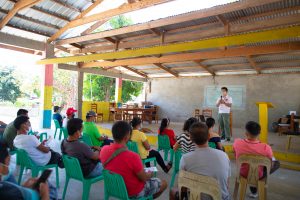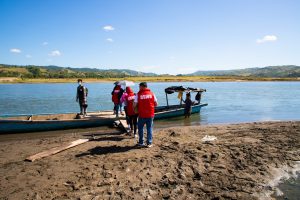Mr. Reymund C. Ferer, Community Development Officer (CDO) IV expressed his feelings towards the communities in the six (6) barangays in Sto. Nino, Cagayan. The KALAHI-CIDSS Social Development Unit Head said, “Kailangan nila ng tulong” (they need help) referring to the dire need of the people specifically access roads going to the markets and to the city proper.
Santo Niño, officially the Municipality of Santo Niño formerly known as Faire, is a 2nd class municipality in the province of Cagayan where the people live in areas where they have to cross the Chico River through a means of transportation called “Bangka”. The KALAHI-CIDSS PAMANA Program is primarily geared to help these communities.
The eligibility to the program is attributed to its identification as one of the conflict-afflicted areas in the region.
WHAT IS KALAHI-CIDSS PAMANA?

KALAHI-CIDSS
The KALAHI-CIDSS: KKB Project is a community-driven development initiative of DSWD that aims to reduce poverty and vulnerabilities to poverty by addressing negative conditions relating to:
(i) Lack of capacity and resources at the local level; and,
(ii) Limited responsiveness of local governance to development community priorities.
KALAHI-CIDSS is recognized in the current Philippine Medium-Term Development Plan as a strategy that responds to basic needs of the poor. It addresses three of the four strategy pillars of poverty alleviation in the Medium-Term Philippine Development Plan (2004-2010) of the national government:
(i) Good governance and rule of law;
(ii) Comprehensive human development and protecting the vulnerable;
(iii) Agriculture and fisheries modernization with social equity; and,
(iv) Macro-economic stability and equitable growth based on free enterprise.
PAMANA
The PAMANA (“Peaceful and Resilient Communities”) is the Philippines Government’s peace and development framework that aims to strengthen peace building, reconstruction and development in conflict affected areas (CAAs). It is in line with the government’s goal of putting a permanent and just closure to internal armed conflicts of the country.
WHAT IS THE COVERAGE OF KALAHI-CIDSS?

In the expansion of Kalahi-CIDSS into the National Community-Driven Development Program (NCDDP), the following municipalities are eligible for coverage by the program:
- 4th – 6th class municipalities identified as “poor”, that is, with poverty incidence above the national average of 26.5%, based on the 2009 Small Area Estimates (SAE) of the National Statistical Coordination Board (NSCB); and
- 1st – 3rd class municipalities with high poverty incidence (40% or higher).
- Municipalities affected by Tropical Storm Haiyan (local name: Yolanda) within the targeted provinces of the NCDDP.
THE IMPLEMENTATION OF KALAHI-CIDSS THROUGOUT THE COUNTRY
The program was piloted in Dolores, Quezon in 2002. It was then rolled out in 2003.
Employing community-driven development (CDD) as a strategy, KALAHI-CIDSS trains and engages communities together with their local governments (barangay and municipal) to choose, design, and implement development projects to address their most pressing needs.
With Kalahi-CIDSS assistance, communities and local government units have built school buildings, farm-to-market roads and bridges, health stations, day care centers, common service post-harvest facilities, and many others, small-scale but responsive to community-identified needs.
KALAHI-CIDSS IN REGION II
The region formally started the program by subjecting the KALAHI-CIDSS Staff to an orientation conducted by the National Program Management Office (NPMO) spell out. After being oriented and trained on the different processes pertaining to KALAHI, they started the Social Preparation stage which is the first phase of the Community Empowerment Activity Cycle (CEAC) Process wherein the community and the Barangay leaders are being oriented and trained on how to implement the project.
As of today, the KALAHI-CIDSS Staff is already on the second phase of Social Preparation Stage wherein the six (6) barangays, Lipatan, Tamucco, Abriongan Uneg, Calassitan, Niug Norte and Mapitac have identified the sub-projects to be implemented in their respective areas
With the identification of the sub-projects, the Engineering team headed by Engr. Ian L. Navarro, Project Development Officer (PDO) IV, conducted a week long Site Validation to the said barangays. Engr. Navarro said, “Nakikita kong very supportive ang community at very excited sila kaya alam kong kakayanin naming matapos ang poject.” (Seeing that the community is very supportive and very excited, I am certain that we can finish the project).
Once the Site Validation is completed, the sub-projects are set to be finalized.
###written by Kayle Angelie Palattao

